Spatial-Temporal Variation Characteristics of Vertical Dust Flux Simulated by WRF-Chem Model with GOCART and AFWA Dust Emission Schemes (Case Study: Central Plateau of Iran)
Abstract
Featured Application
Abstract
1. Introduction
2. Materials and Methods
2.1. Study Area
2.2. Selecting Dust Events
2.2.1. Synoptic Data
2.2.2. MODIS Data
2.2.3. Determination of Dust Storm Origin Using HYSPLIT
2.3. WRF-Chem Model
2.3.1. Dust Schemes in WRF-Chem
GOCART Dust Scheme
Dust Scheme AFWA
2.3.2. WRF-Chem Model Configuration
2.4. Verification of Results
3. Results
3.1. Dust Storm Selectin
3.2. Detection with MODIS Images
3.3. Simulation of Dust Storm on 14 February 2018
3.3.1. Spatial Pattern of Vertical Dust Flux Using AFWA Wind Erosion Scheme
3.3.2. Spatial Pattern of Vertical Dust Flux Using GOCART Wind Erosion Model
3.4. Simulation of Dust Storm on 21 February 2015
3.4.1. Spatial Pattern of Vertical Dust Flux Using AFWA Wind Erosion Scheme
3.4.2. Spatial Pattern of Vertical Dust Flux Using GOCART Wind Erosion Scheme
3.5. Validation of WRF-Chem with GOCART and AFWA Wind Erosion Schemes
3.5.1. Validation of WRF-Chem by Horizontal Visibility
3.5.2. Validation of WRF-Chem by MERRA2 Dataset
Numerical Simulation of Storm Dust Surface Concentration on 14 February 2018 with AFWA and GOCART Schemes
4. Discussion and Conclusions
Author Contributions
Funding
Acknowledgments
Conflicts of Interest
References
- Obregón, M.A.; Pereira, S.N.; Salgueiro, V.; Costa, M.J.; Silva, A.M.; Serrano, A.; Bortoli, D. Aerosol radiative effects during two desert dust events in August 2012 over the Southwestern Iberian Peninsula. Atmos. Res. 2015, 153, 404–415. [Google Scholar] [CrossRef]
- Chen, Y.S.; Sheen, P.C.; Chen, E.R.; Liu, Y.K.; Wu, T.N.; Yang, C.Y. Effects of Asian dust storm events on daily mortality in Taipei, Taiwan. Environ. Res. 2004, 95, 151–155. [Google Scholar] [CrossRef] [PubMed]
- Kim, K.W.; Kim, Y.J.; Oh, S.J. Visibility impairment during Yellow Sand periods in the urban atmosphere of Kwangju, Korea. Atmos. Environ. 2001, 35, 5157–5167. [Google Scholar] [CrossRef]
- Middleton, N. Desert dust hazards: A global review. Aeolian Res. 2017, 24, 53–63. [Google Scholar] [CrossRef]
- Vaghefi, S.A.; Keykhai, M.; Jahanbakhshi, F.; Sheikholeslami, J.; Ahmadi, A.; Yang, H.; Abbaspour, K.C.; Ahmadi, A. The future of extreme climate in Iran. Sci. Rep. 2019, 9, 1464. [Google Scholar] [CrossRef]
- Buschiazzo, D.E.; Zobeck, T.M. Validation of WEQ, RWEQ and WEPS wind erosion for different arable land management systems in the Argentinean Pampas. Earth Surf. Process. Landf. 2008, 33, 1839–1850. [Google Scholar] [CrossRef]
- Webb, N.P.; McGowan, H.; Phinn, S.; Leys, J.F.; McTainsh, G.H. A model to predict land susceptibility to wind erosion in western Queensland, Australia. Environ. Model. Softw. 2009, 24, 214–227. [Google Scholar] [CrossRef]
- Gregory, J.; Wilson, G.; Singh, U.; Darwish, M. TEAM: Integrated, process-based wind-erosion model. Environ. Model. Softw. 2004, 19, 205–215. [Google Scholar] [CrossRef]
- Alfaro, S.C.; Gaudichet, A.; Gomes, L.; Maillé, M. Modeling the size distribution of a soil aerosol produced by sandblasting. J. Geophys. Res. Space Phys. 1997, 102, 11239–11249. [Google Scholar] [CrossRef]
- Li, J.; Okin, G.S.; Alvarez, L.; Epstein, H. Quantitative effects of vegetation cover on wind erosion and soil nutrient loss in a desert grassland of southern New Mexico, USA. Biogeochemistry 2007, 85, 317–332. [Google Scholar] [CrossRef]
- Hoffmann, C.; Funk, R.; Reiche, M.; Li, Y. Assessment of extreme wind erosion and its impacts in Inner Mongolia, China. Aeolian Res. 2011, 3, 343–351. [Google Scholar] [CrossRef]
- Nickovic, S.; Kallos, G.; Papadopoulos, A.; Kakaliagou, O. A model for prediction of desert dust cycle in the atmosphere. J. Geophys. Res. Space Phys. 2001, 106, 18113–18129. [Google Scholar] [CrossRef]
- Cope, M.E.; Hess, G.D.; Lee, S.; Tory, K.; Azzi, M.; Carras, J.; Lilley, W.; Manins, P.C.; Nelson, P.F.; Ng, L.; et al. The Australian Air Quality Forecasting System. Part I: Project Description and Early Outcomes. J. Appl. Meteorol. 2004, 43, 649–662. [Google Scholar] [CrossRef]
- Shao, Y.; Yang, Y.; Wang, J.; Song, Z.; Leslie, L.M.; Dong, C.; Zhang, Z.; Lin, Z.; Kanai, Y.; Yabuki, S.; et al. Northeast Asian dust storms: Real-time numerical prediction and validation. J. Geophys. Res. Space Phys. 2003, 108, D22. [Google Scholar] [CrossRef]
- Park, S.H.; Gong, S.L.; Zhao, T.L.; Vet, R.J.; Bouchet, V.S.; Gong, W.; Makar, P.A.; Moran, M.D.; Stroud, C.; Zhang, J. Simulation of entrainment and transport of dust particles within North America in April 2001 (“Red Dust Episode”). J. Geophys. Res. Space Phys. 2007, 112. [Google Scholar] [CrossRef]
- Tanaka, T.; Orito, K.; Sekiyama, T.T.; Shibata, K.; Chiba, M.; Tanaka, H. MASINGAR, a global tropospheric aerosol chemical transport model coupled with MRI/JMA98 GCM: Model description. Pap. Meteorol. Geophys. 2003, 53, 119–138. [Google Scholar] [CrossRef]
- Uno, I.; Satake, S.; Carmichael, G.; Tang, Y.; Wang, Z.; Takemura, T.; Sugimoto, N.; Shimizu, A.; Murayama, T.; Cahill, T.A.; et al. Numerical study of Asian dust transport during the springtime of 2001 simulated with the Chemical Weather Forecasting System (CFORS) model. J. Geophys. Res. Space Phys. 2004, 109. [Google Scholar] [CrossRef]
- Liu, M.; Westphal, D.L.; Wang, S.; Shimizu, A.; Sugimoto, N.; Zhou, J.; Chen, Y. A high-resolution numerical study of the Asian dust storms of April 2001. J. Geophys. Res. Space Phys. 2003, 108. [Google Scholar] [CrossRef]
- Ginoux, P.; Chin, M.; Tegen, I.; Prospero, J.; Holben, B.; Dubovik, O.; Lin, S.-J. Sources and distributions of dust aerosols simulated with the GOCART model. J. Geophys. Res. Space Phys. 2001, 106, 20255–20273. [Google Scholar] [CrossRef]
- Goudie, A.S.; Middleton, N.J. Saharan dust storms: Nature and consequences. Earth Sci. Rev. 2001, 56, 179–204. [Google Scholar] [CrossRef]
- Zender, C.S.; Bian, H.; Newman, D. Mineral Dust Entrainment and Deposition (DEAD) model: Description and 1990s dust climatology. J. Geophys. Res. Space Phys. 2003, 108, 4416. [Google Scholar] [CrossRef]
- Shao, Y. A model for mineral dust emission. J. Geophys. Res. Space Phys. 2001, 106, 20239–20254. [Google Scholar] [CrossRef]
- Grell, G.; Peckham, S.E.; Schmitz, R.; McKeen, S.A.; Frost, G.; Skamarock, W.C.; Eder, B. Fully coupled “online” chemistry within the WRF model. Atmos. Environ. 2005, 39, 6957–6975. [Google Scholar] [CrossRef]
- Peckham, S.E.; Fast, J.; Schmitz, R.; Grell, G.A.; Gustafson, W.I.; McKeen, S.A.; Ghan, S.J.; Zaveri, R.; Easter, R.C.; Barnard, J.; et al. WRF/Chem Version 3.3 User’s Guide; NOAA Technical Memo; NOAA: Silver Spring, MD, USA, 2011.
- Nabavi, S.O.; Haimberger, L.; Samimi, C. Sensitivity of WRF-chem predictions to dust source function specification in West Asia. Aeolian Res. 2017, 24, 115–131. [Google Scholar] [CrossRef]
- Su, L.; Fung, J.C.H. Sensitivities of WRF-Chem to dust emission schemes and land surface properties in simulating dust cycles during Sourcetime over East Asia. J. Geophys. Res. Atmos. 2015, 120, 11215–11230. [Google Scholar] [CrossRef]
- Xiaolan, L.; Hongsheng, Z. Soil Moisture Effects on Sand Saltation and Dust Emission Observed over the Horqin Sandy Land Area in China. J. Meteorol. Res. 2014, 28, 444–452. [Google Scholar]
- Rizza, U.; Miglietta, M.M.; Mangia, C.; Ielpo, P.; Morichetti, M.; Iachini, C.; Virgili, S.; Passerini, G. Sensitivity of WRF-Chem model to land surface schemes: Assessment in a severe dust outbreak episode in the Central Mediterranean (Apulia Region). Atmos. Res. 2018, 201, 168–180. [Google Scholar] [CrossRef]
- Song, H.; Wang, K.; Zhang, Y.; Hong, C.; Zhou, S. Simulation and evaluation of dust emissions with WRF-Chem (v3.7.1) and its relationship to the changing climate over East Asia from 1980 to 2015. Atmos. Environ. 2017, 167, 511–522. [Google Scholar] [CrossRef]
- Teixeira, J.; Carvalho, A.; Tuccella, P.; Curci, G.; Rocha, A. WRF-chem sensitivity to vertical resolution during a saharan dust event. Phys. Chem. Earth Parts A/B/C 2016, 94, 188–195. [Google Scholar] [CrossRef]
- Tang, Y.; Han, Y.; Liu, Z. Temporal and spatial characteristics of dust devils and their contribution to the aerosol budget in East Asia—An analysis using a new parameterization scheme for dust devils. Atmos. Environ. 2018, 182, 225–233. [Google Scholar] [CrossRef]
- Chen, S.; Yuan, T.; Zhang, X.; Zhang, G.; Feng, T.; Zhao, D.; Zang, Z.; Liao, S.; Ma, X.; Jiang, N.; et al. Dust modeling over East Asia during the summer of 2010 using the WRF-Chem model. J. Quant. Spectrosc. Radiat. Transf. 2018, 213, 1–12. [Google Scholar] [CrossRef]
- Alizadeh-Choobari, O.; Zawar-Reza, P.; Sturman, A. Low level jet intensification by mineral dust aerosols. Ann. Geophys. 2013, 31, 625–632. [Google Scholar] [CrossRef]
- Alizadeh-Choobari, O.; Zawar-Reza, P.; Sturman, A. The “wind of 120days” and dust storm activity over the Sistan Basin. Atmos. Res. 2014, 143, 328–341. [Google Scholar] [CrossRef]
- Chin, M.; Savoie, D.L.; Huebert, B.J.; Bandy, A.; Thornton, D.C.; Bates, T.S.; Quinn, P.; Saltzman, E.S.; De Bruyn, W.J. Atmospheric sulfur cycle simulated in the global model GOCART: Comparison with field observations and regional budgets. J. Geophys. Res. Space Phys. 2000, 105, 24689–24712. [Google Scholar] [CrossRef]
- Flaounas, E.; Kotroni, V.; Lagouvardos, K.; Klose, M.; Flamant, C.; Giannaros, T.M. Assessing atmospheric dust modelling performance of WRF-Chem over the semi-arid and arid regions around the Mediterranean. Atmos. Chem. Phys. Discuss. 2016, 1–28. [Google Scholar] [CrossRef]
- Uzan, L.; Egert, S.; Alpert, P. Ceilometer evaluation of the eastern Mediterranean summer boundary layer height—First study of two Israeli sites. Atmos. Meas. Tech. 2016, 9, 4387–4398. [Google Scholar] [CrossRef]
- Cremades, P.G.; Fernández, R.P.; Allende, D.G.; Mulena, G.C.; Puliafito, S.E. High resolution satellite derived erodibility factors for WRF/Chem windblown dust simulations in Argentina. Atmósfera 2017, 30, 11–25. [Google Scholar] [CrossRef]
- Fast, J.D.; Gustafson, W.I., Jr.; Easter, R.C.; Zaveri, R.A.; Barnard, J.C.; Chapman, E.G.; Grell, G.A.; Peckham, S.E. Evolution of ozone, particulates, and aerosol direct forcing in an urban area using a new fully-coupled meteorology, chemistry, and aerosol model. J. Geophys. Res. 2006, 111, D21305. [Google Scholar] [CrossRef]
- Kalenderski, S.; Stenchikov, G.; Zhao, C. Modeling a typical winter-time dust event over the Arabian Peninsula and the Red Sea. Atmos. Chem. Phys. Discuss. 2013, 13, 1999–2014. [Google Scholar] [CrossRef]
- Kumar, R.; Barth, M.C.; Pfister, G.G.; Naja, M.; Brasseur, G.P. WRF-Chem simulations of a typical pre-monsoon dust storm in northern India: Influences on aerosol optical properties and radiation budget. Atmos. Chem. Phys. Discuss. 2014, 14, 2431–2446. [Google Scholar] [CrossRef]
- Prakash, P.J.; Stenchikov, G.; Kalenderski, S.; Osipov, S.; Bangalath, H.K. The impact of dust storms on the Arabian Peninsula and the Red Sea. Atmos. Chem. Phys. Discuss. 2015, 15, 199–222. [Google Scholar] [CrossRef]
- Zhao, C.; Liu, X.; Leung, L.R.; Johnson, B.; McFarlane, S.A.; Gustafson, W.I., Jr.; Fast, J.D.; Easter, R. The spatial distribution of mineral dust and its shortwave radiative forcingover North Africa: Modeling sensitivities to dust emissions and aerosol size treatments. Atmos. Chem. Phys. 2010, 10, 8821–8838. [Google Scholar] [CrossRef]
- Zhao, C.; LiuiD, X.; Leung, L.R.; Hagos, S. Radiative impact of mineral dust on monsoon precipitation variability over West Africa. Atmos. Chem. Phys. Discuss. 2011, 11, 1879–1893. [Google Scholar] [CrossRef]
- Zhao, C.; Chen, S.; Leung, L.R.; Qian, Y.; Kok, J.F.; Zaveri, R.A.; Huang, J. Uncertainty in modeling dust mass balance and radiative forcing from size parameterization. Atmos. Chem. Phys. 2013, 13, 10733–10753. [Google Scholar] [CrossRef]
- Dipu, S.; Prabha, T.V.; Pandithurai, G.; Dudhia, J.; Pfister, G.; Rajesh, K.; Goswami, B. Impact of elevated aerosol layer on the cloud macrophysical properties prior to monsoon onset. Atmos. Environ. 2013, 70, 454–467. [Google Scholar] [CrossRef]
- Karegar, E.; Hamzeh, N.H.; Jamali, J.B.; Abadi, A.R.S.; Moeinaddini, M.; Goshtasb, H. Numerical simulation of extreme dust storms in east of Iran by the WRF-Chem model. Nat. Hazards 2019, 99, 769–796. [Google Scholar] [CrossRef]
- Farhadipour, S.; Azadi, M.; Bidokhti, A.A.; Sayyari, H.; Choobari, O.A. Study and Simulation of Severe Dust Storms in the West and Southwest of Iran. Russ. Meteorol. Hydrol. 2018, 43, 613–624. [Google Scholar] [CrossRef]
- Azadi, S.; Soltani Kopaei, S.; Faramarzi, M.; Soltani Tudeshki, A.; Pornmanafi, S. Evaluation of the Palmer Drought Index in Central Iran. J. Water Soil Sci. 2015, 19, 305–318. [Google Scholar] [CrossRef]
- Naderi, M.; Raeisi, E. Climate change in a region with altitude differences and with precipitation from various sources, South-Central Iran. Theor. Appl. Clim. 2015, 124, 529–540. [Google Scholar] [CrossRef]
- Jafari, M.; Zehtabian, G.; Mesbahzadeh, T. Statistical analysis of the dust storm phenomenon (case study: Isfahan). Iran. J. Range Desert Res. 2019, 25, 863–876. [Google Scholar]
- Azizi, G.; Shamsipour, A.; Miri, M.; Safarrad, T. Synoptic and remote sensing analysis of dust events in southwestern Iran. Nat. Hazards 2012, 64, 1625–1638. [Google Scholar]
- Earthdata Search. Available online: https://search.earthdata.nasa.gov/search/granules (accessed on 14 February 2018).
- Ackerman, S. Remote sensing aerosols using satellite infrared observations. J. Geophys. Res. Space Phys. 1997, 102, 17069–17079. [Google Scholar] [CrossRef]
- Draxler, R.R.; Hess, G.D. Description of the HYSPLIT_4 modeling system. In NOAA Tech. Memo. ERL ARL-224; Air Resources Laboratory: Silver Spring, MD, USA, 1997. [Google Scholar]
- Stein, A.; Draxler, R.R.; Rolph, G.D.; Stunder, B.J.B.; Cohen, M.D.; Ngan, F. NOAA’s HYSPLIT Atmospheric Transport and Dispersion Modeling System. Bull. Am. Meteorol. Soc. 2015, 96, 2059–2077. [Google Scholar] [CrossRef]
- Rolph, G.; Stein, A.; Stunder, B. Real-time Environmental Applications and Display System: READY. Environ. Model. Softw. 2017, 95, 210–228. [Google Scholar] [CrossRef]
- Shao, Y.; Dong, C. A review on East Asian dust storm climate, modelling and monitoring. Glob. Planet. Chang. 2006, 52, 1–22. [Google Scholar] [CrossRef]
- Shao, Y.; Wyrwoll, K.-H.; Chappell, A.; Huang, J.; Lin, Z.; McTainsh, G.; Mikami, M.; Tanaka, T.; Wang, X.; Yoon, S. Dust cycle: An emerging core theme in Earth system science. Aeolian Res. 2011, 2, 181–204. [Google Scholar] [CrossRef]
- Hamzeh, N.H.; Karami, S.; Ranjbar, A. Simulation of a severe dust storm with different dust emission schemes. E3s Web Conf. 2019, 99, 02013. [Google Scholar] [CrossRef]
- Gillette, D.A.; Passi, R. Modeling dust emission caused by wind erosion. J. Geophys. Res. Space Phys. 1988, 93, 14233–14242. [Google Scholar] [CrossRef]
- Marticorena, B.; Bergametti, G. Modeling the atmospheric dust cycle: 1. Design of a soil-derived dust emission scheme. J. Geophys. Res. Space Phys. 1995, 100, 16415. [Google Scholar] [CrossRef]
- Jones, S.L.; Adams-Selin, R.; Hunt, E.D.; Creighton, G.A.; Cetola, J.D. Update on modifications to WRF-CHEM GOCART for fine-scale dust forecasting at AFWA. In Proceedings of the AGU Fall Meeting, New Orleans, LA, USA, 11–15 December 2012. [Google Scholar]
- Kawamura, R. Study on sand movement by wind. Inst. Sci. Technol. Rep. 1951, 5, 95–112. (In Japanese) [Google Scholar]
- Holben, B.; Eck, T.; Slutsker, I.; Tanre, D.; Buis, J.; Setzer, A.; Vermote, E.; Reagan, J.; Kaufman, Y.; Nakajima, T.; et al. AERONET—A Federated Instrument Network and Data Archive for Aerosol Characterization. Remote Sens. Environ. 1998, 66, 1–16. [Google Scholar] [CrossRef]
- Chen, S.; Zhao, C.; Qian, Y.; Leung, L.R.; Huang, J.; Huang, Z.; Bi, J.; Zhang, W.; Shi, J.; Yang, L.; et al. Regional modeling of dust mass balance and radiative forcing over East Asia using WRF-Chem. Aeolian Res. 2014, 15, 15–30. [Google Scholar] [CrossRef]
- Cao, H.; Liu, J.; Wang, G.; Yang, G.; Luo, L. Identification of sand and dust storm source areas in Iran. J. Arid Land 2015, 7, 567–578. [Google Scholar] [CrossRef]
- Baghbanan, P.; Ghavidel, Y.; Farajzadeh, M. Spatial analysis of spring dust storms hazard in Iran. Theor. Appl. Clim. 2019, 139, 1447–1457. [Google Scholar] [CrossRef]
- Rezazadeh, M.; Irannejad, P.; Shao, Y. Dust emission simulation with the WRF-Chem model using new surface data in the Middle East region. J. Earth Space Phys. 2013, 39, 191–212. [Google Scholar]
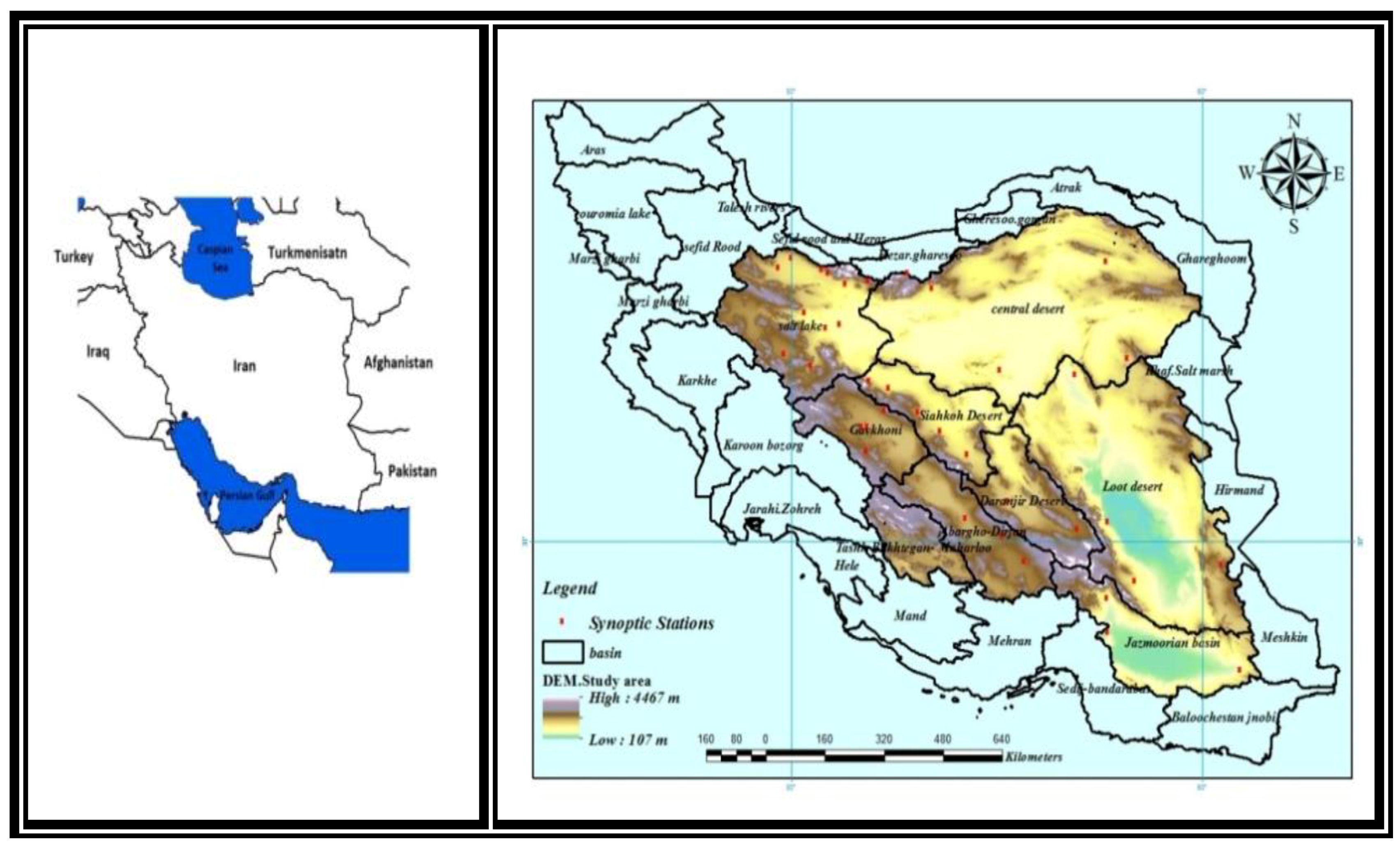
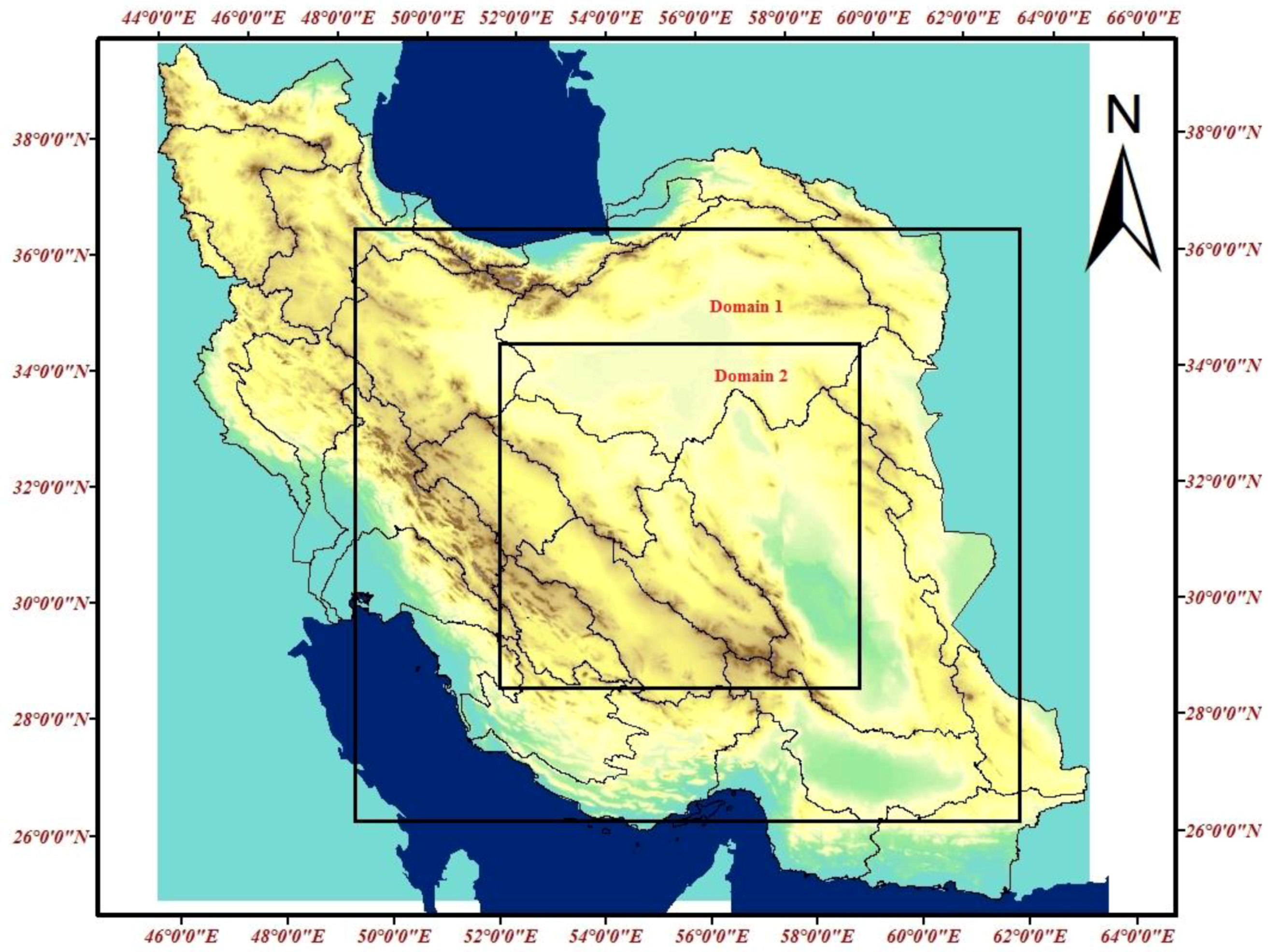
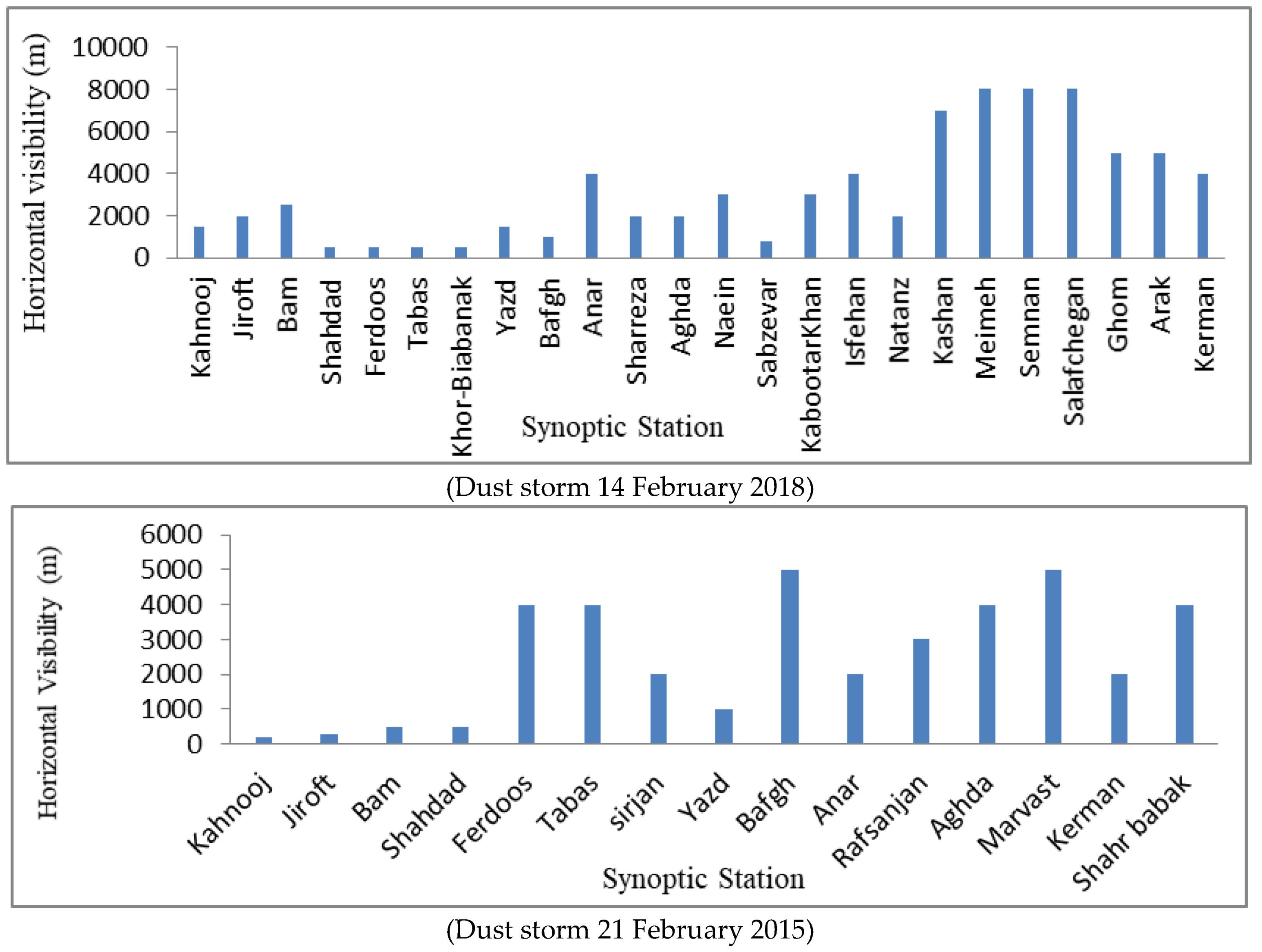

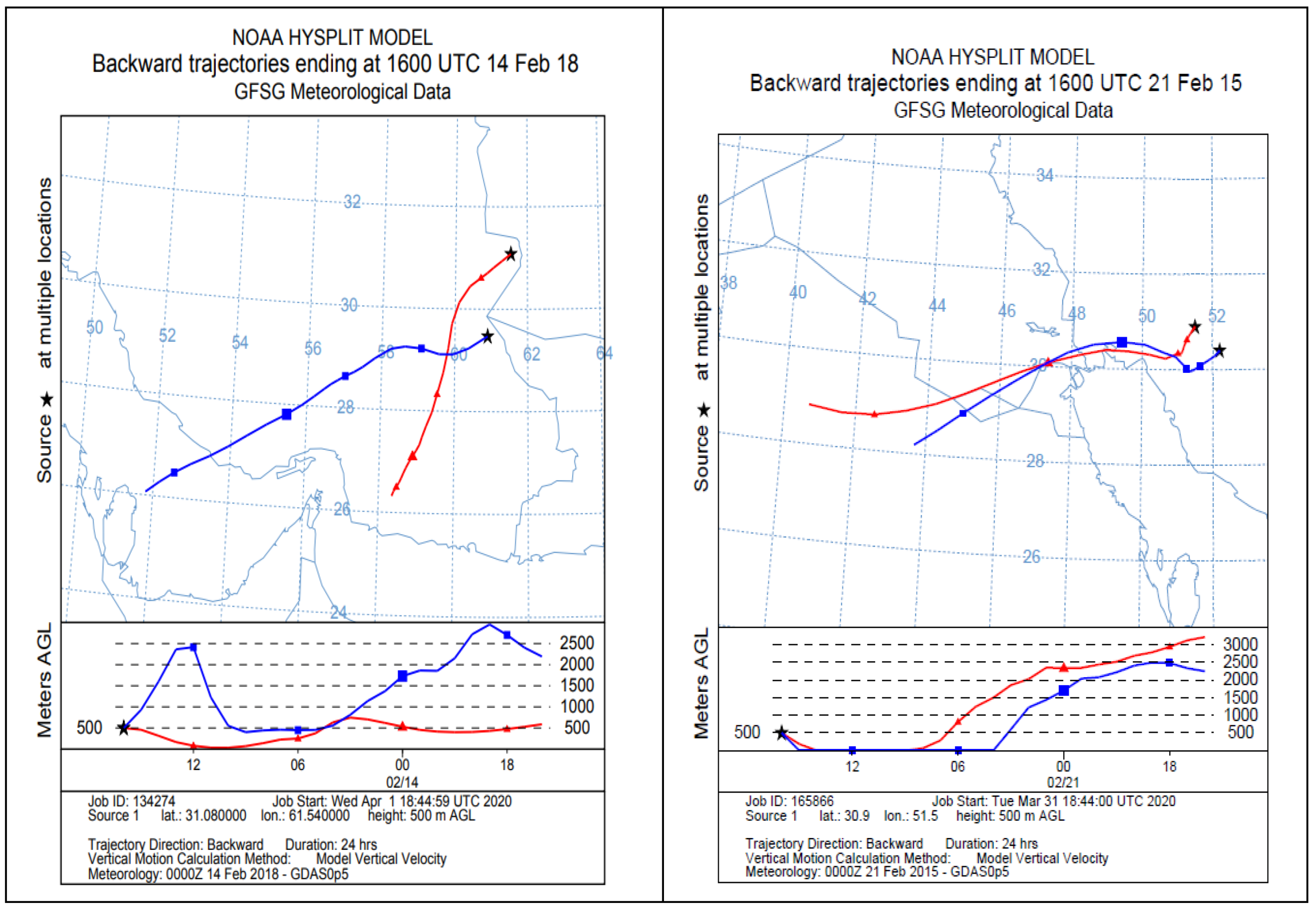
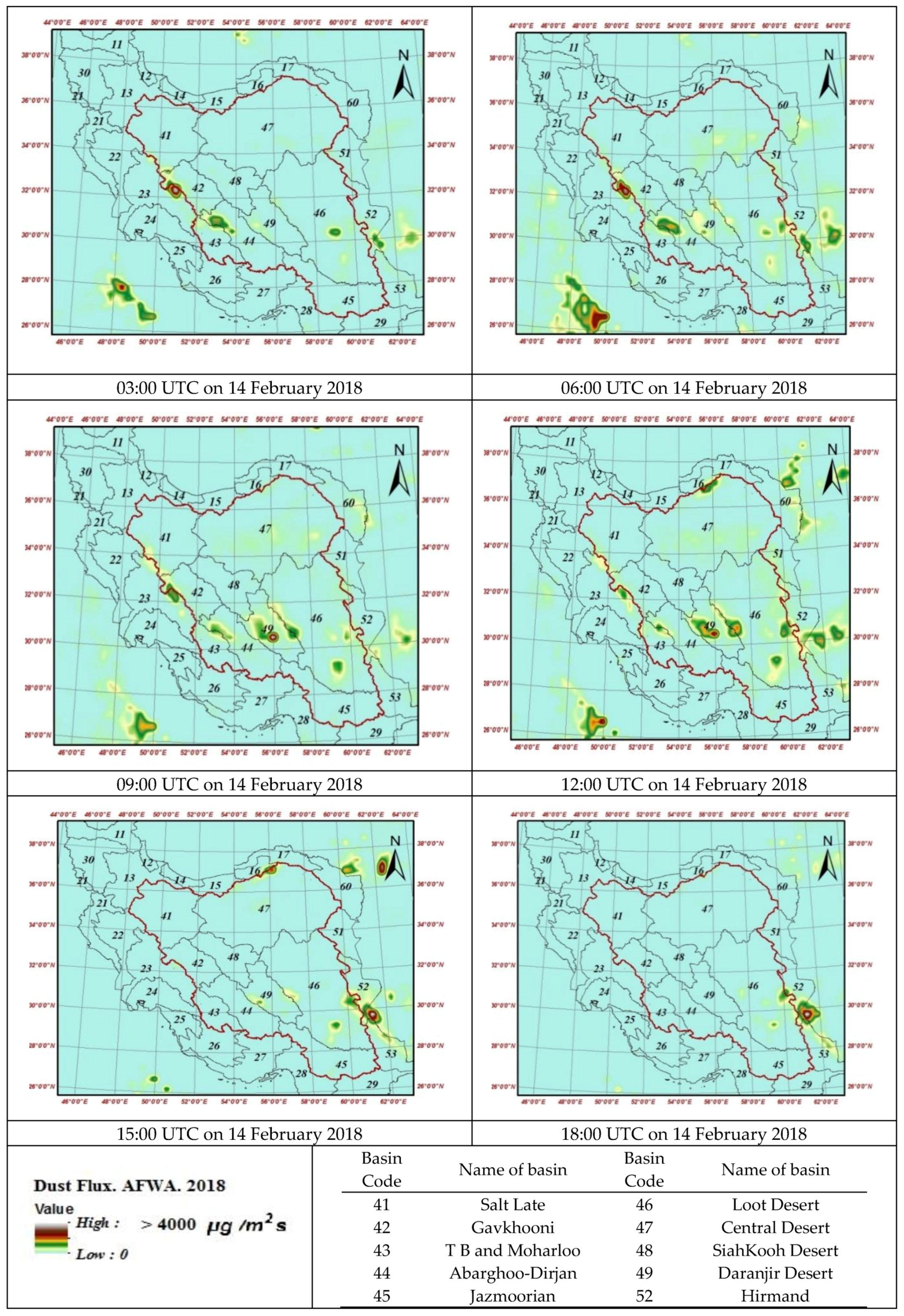
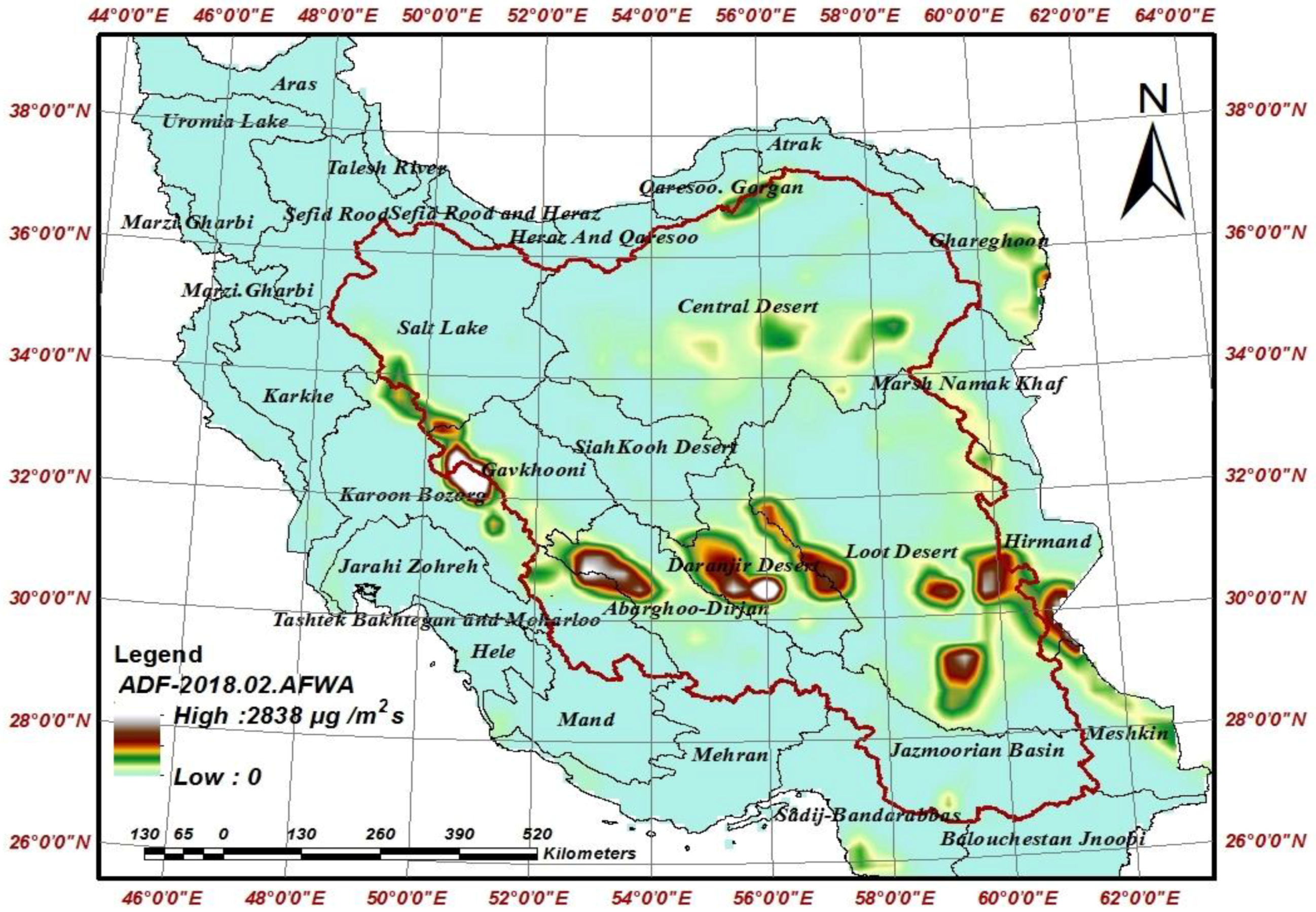
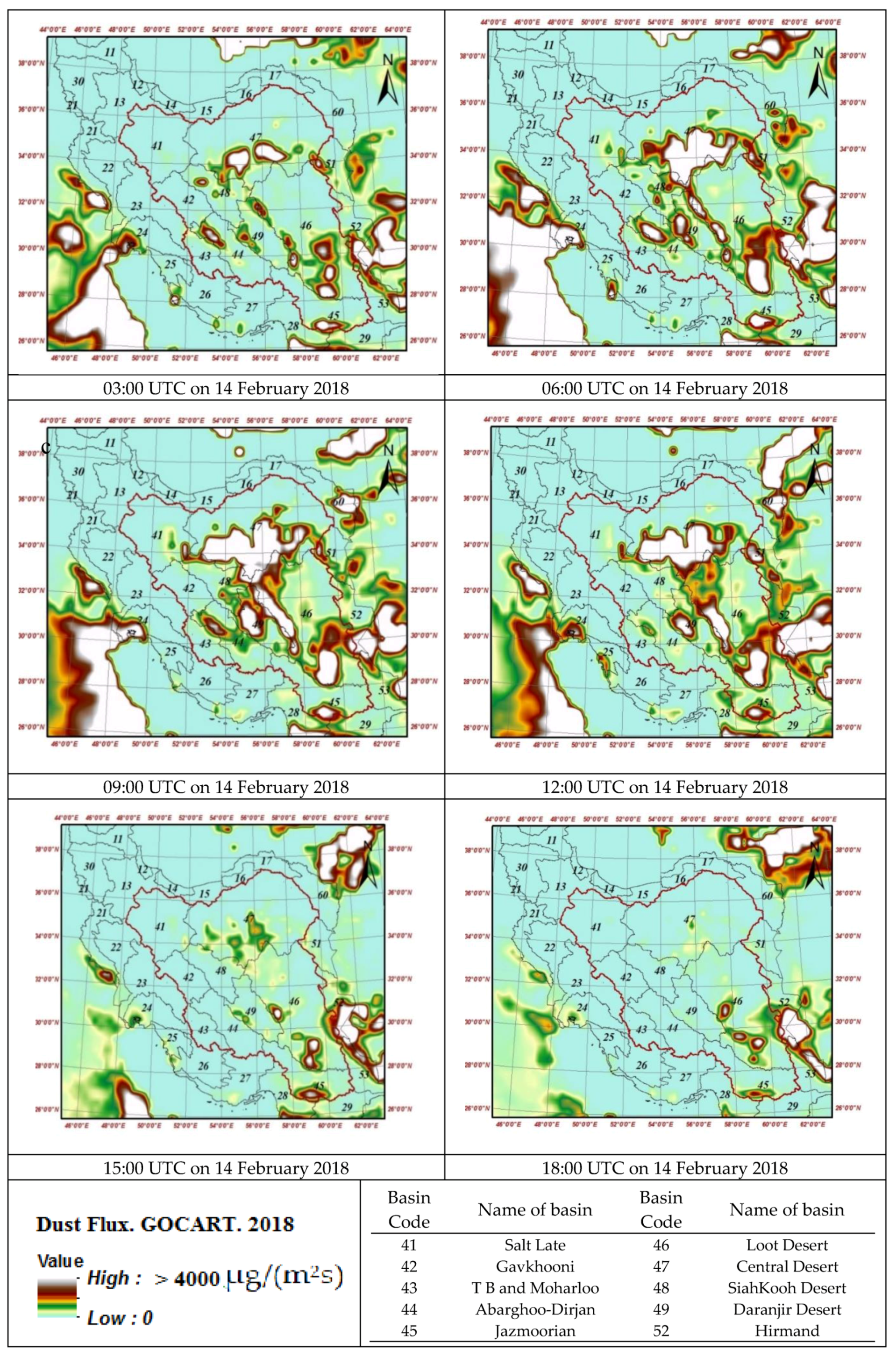
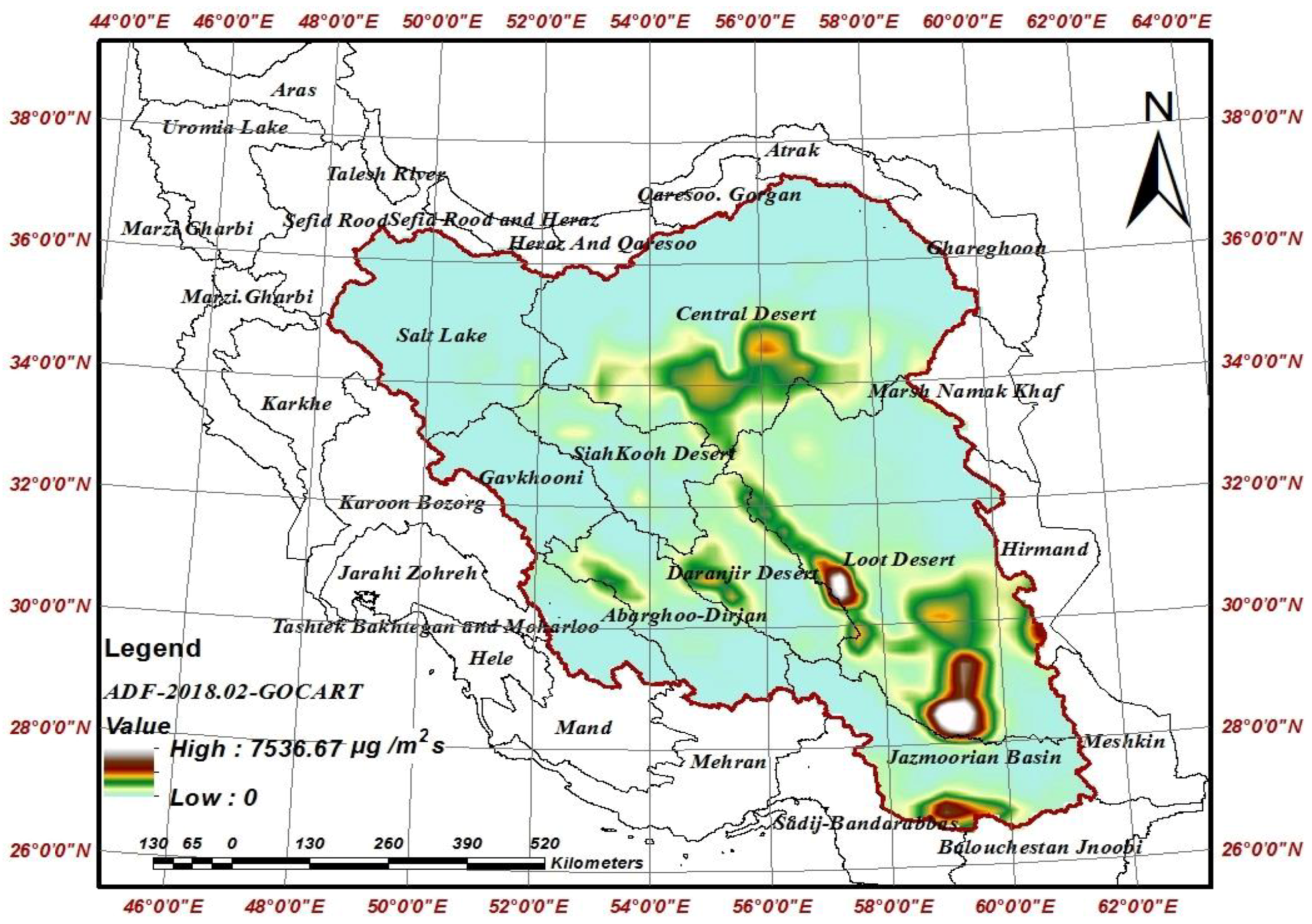
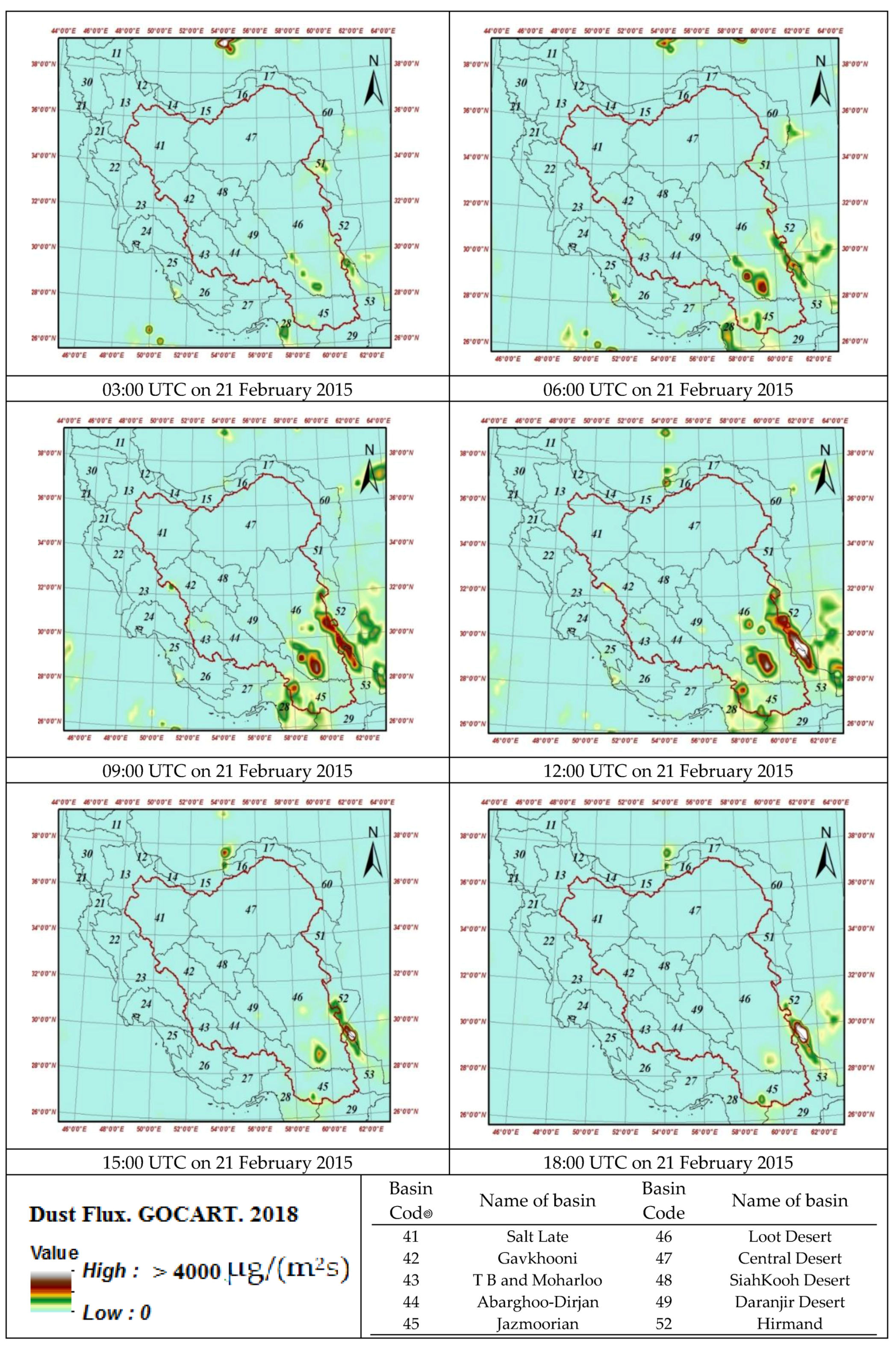
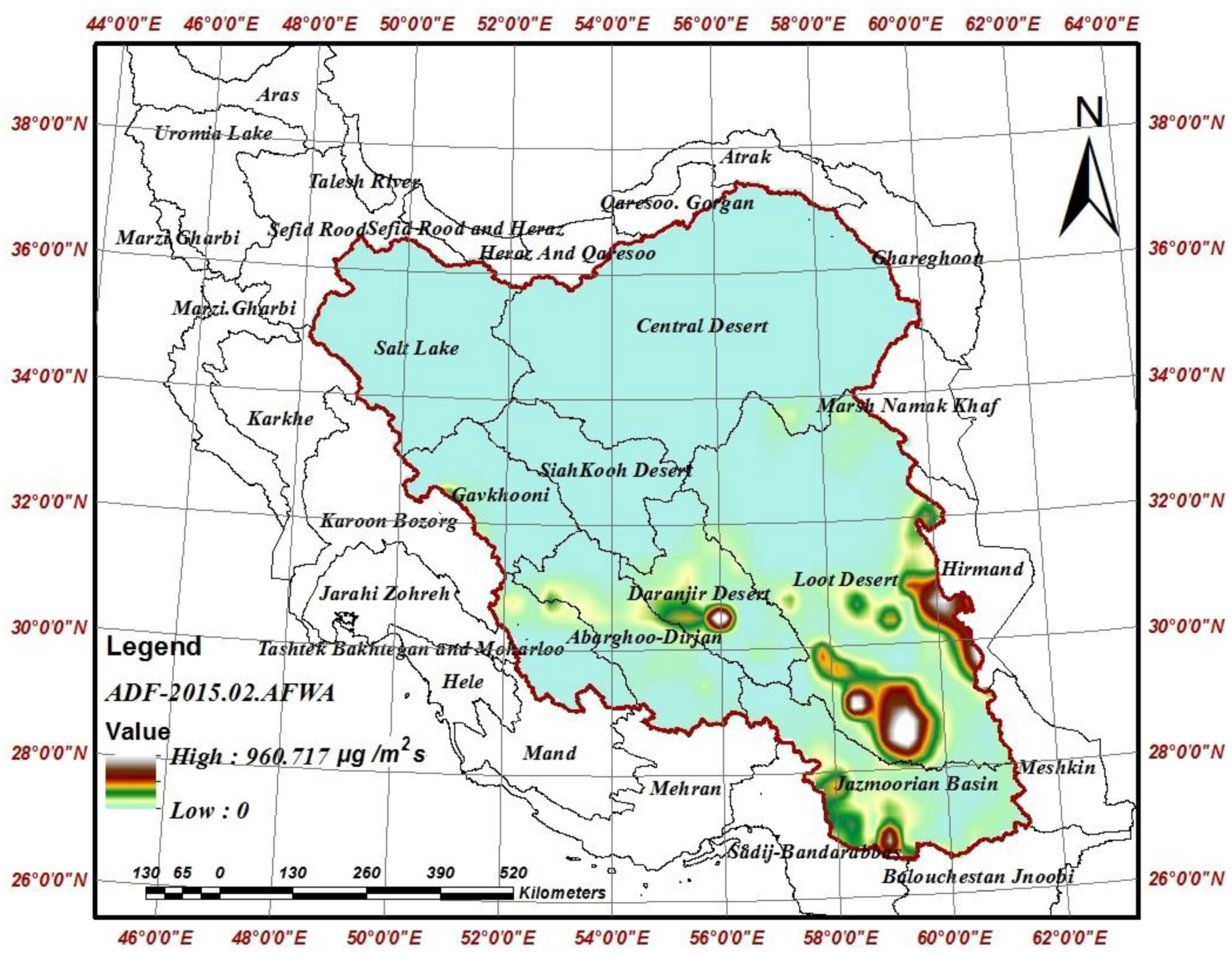
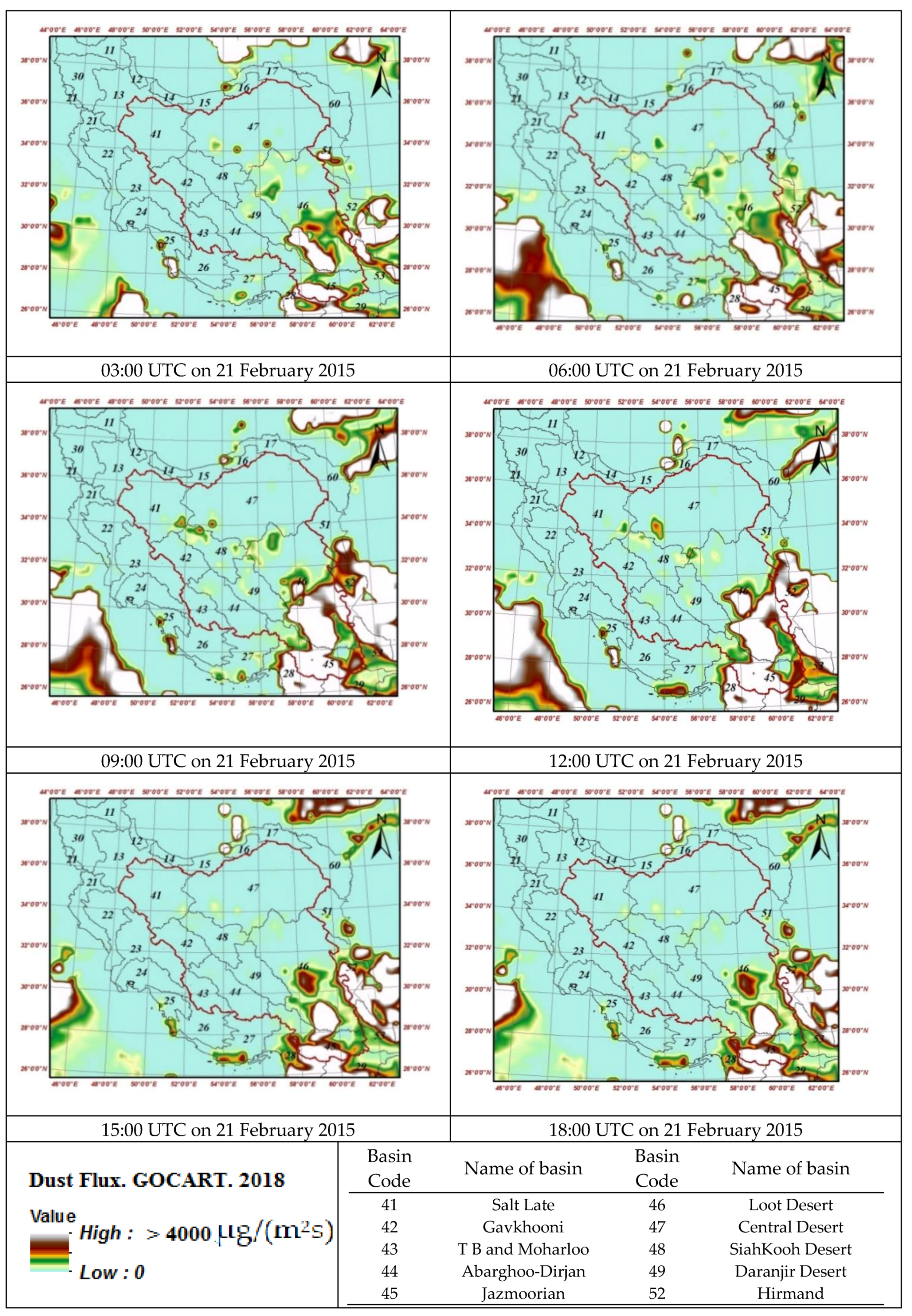
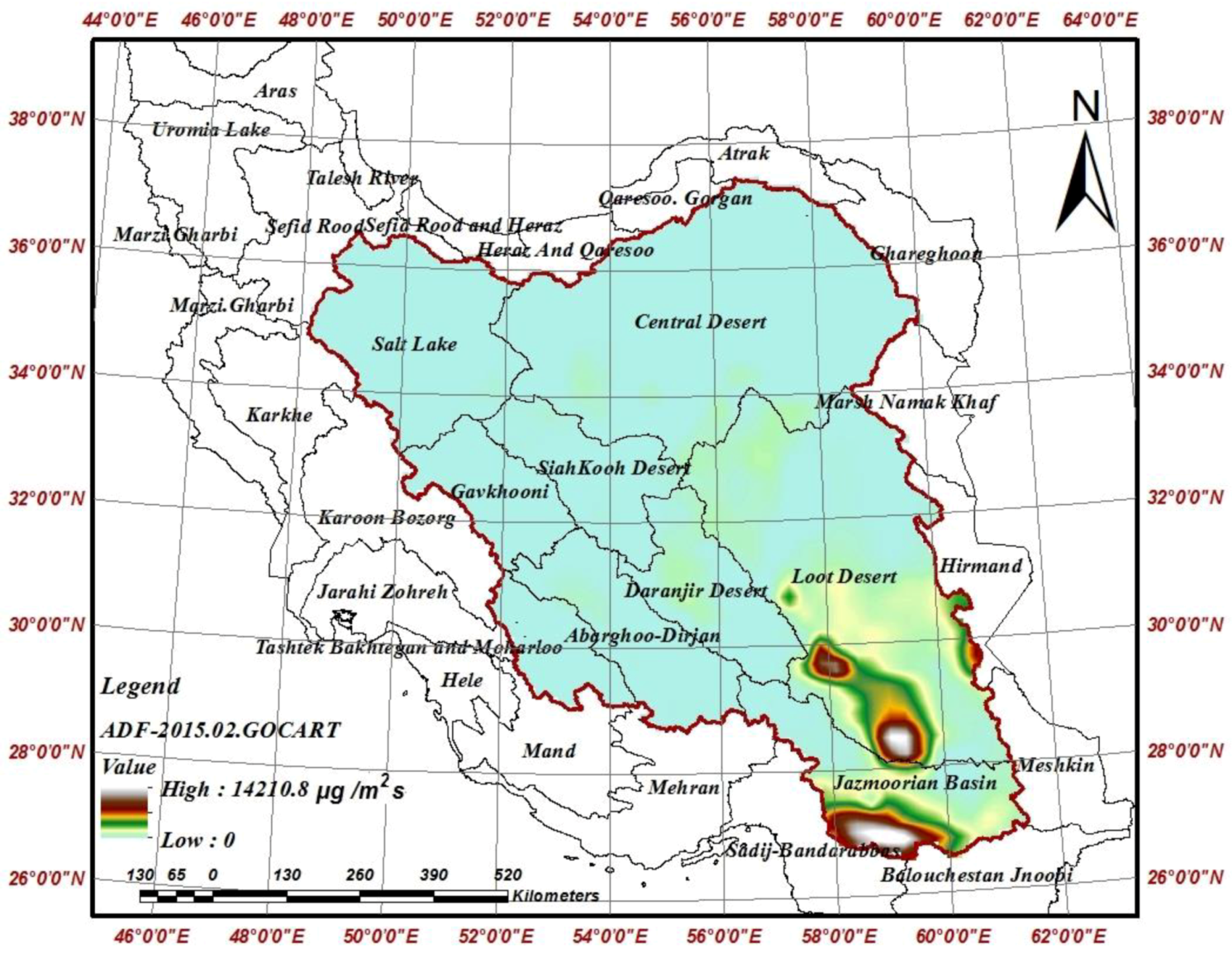
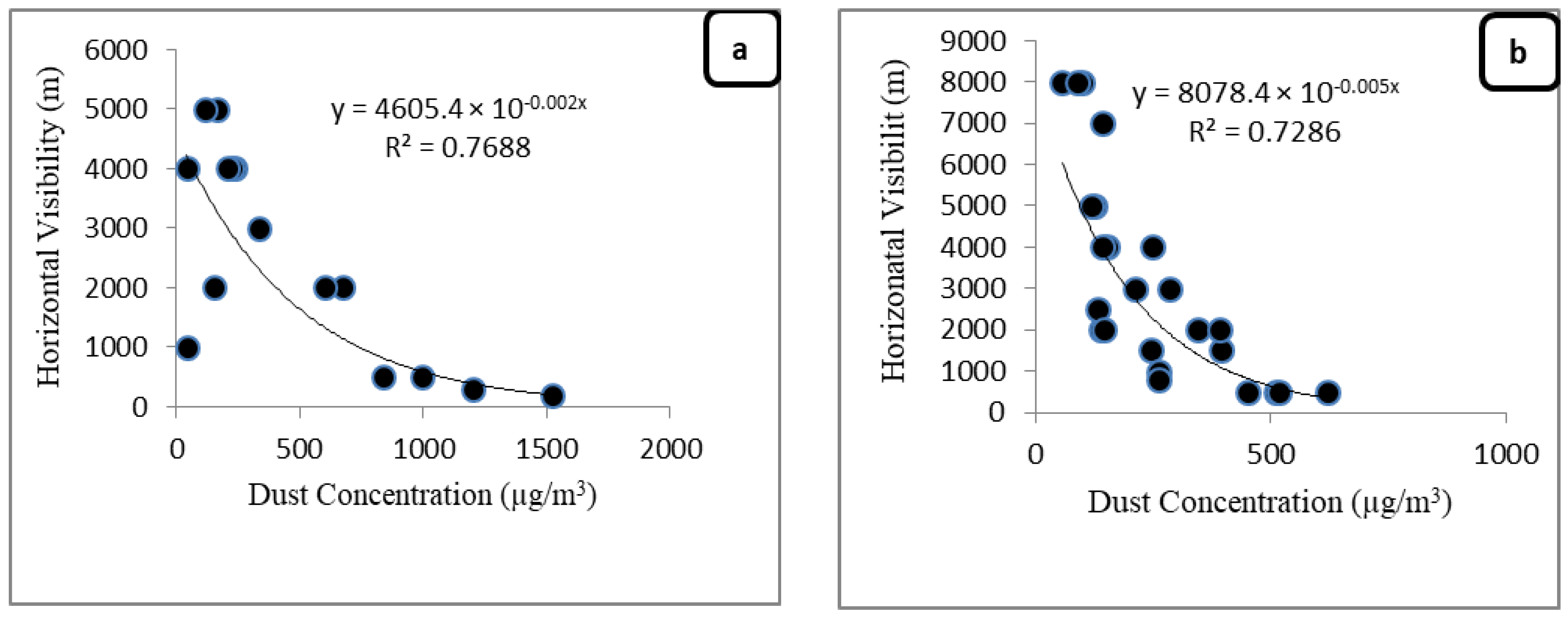
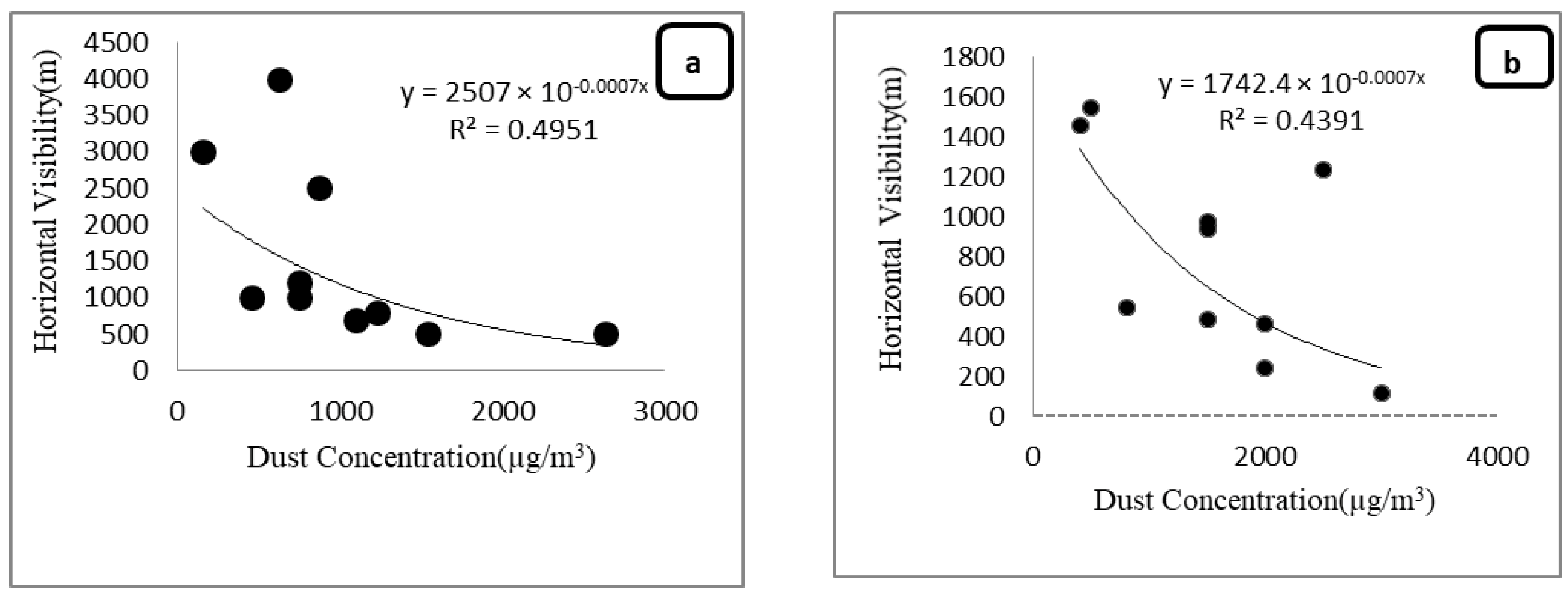

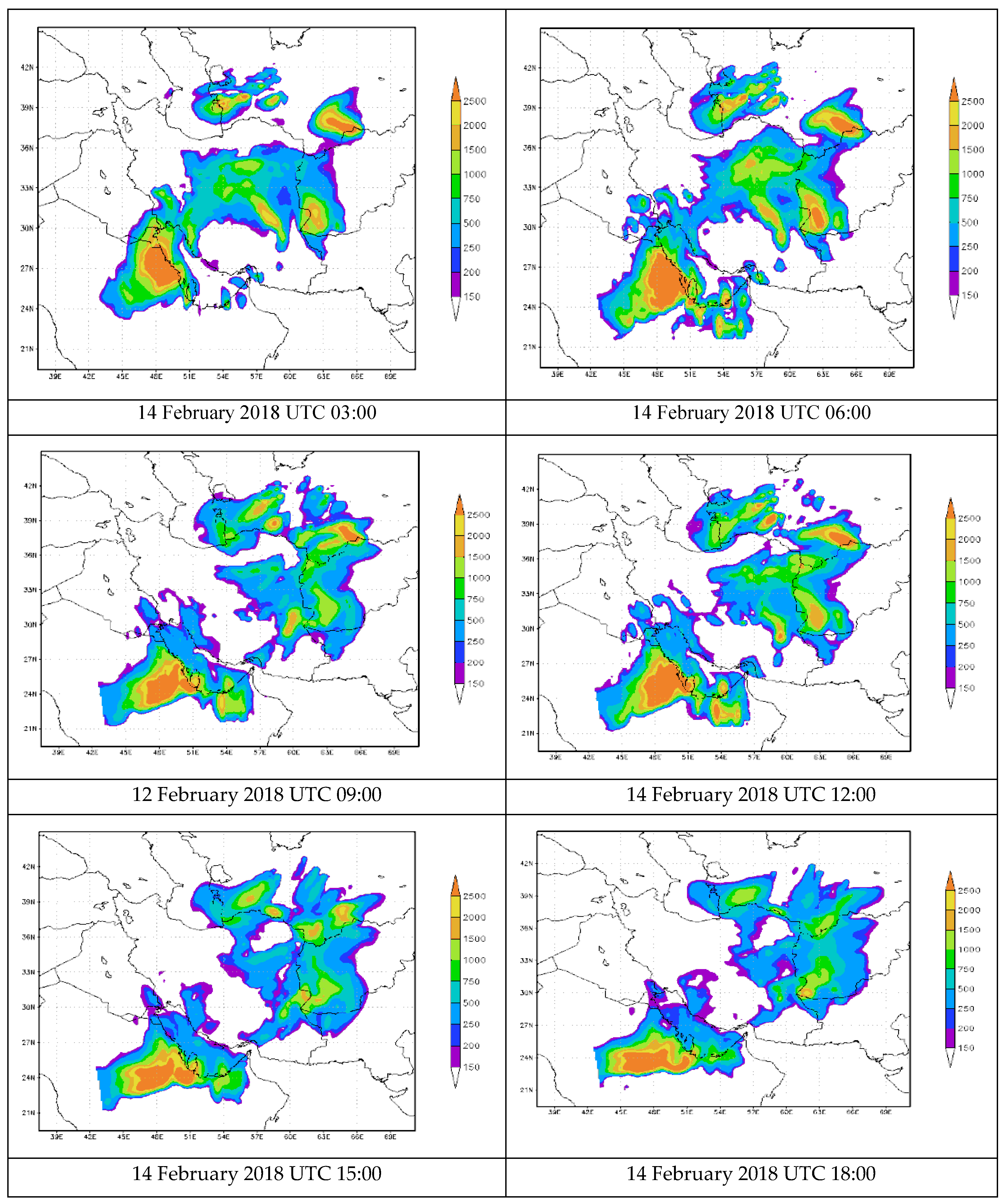
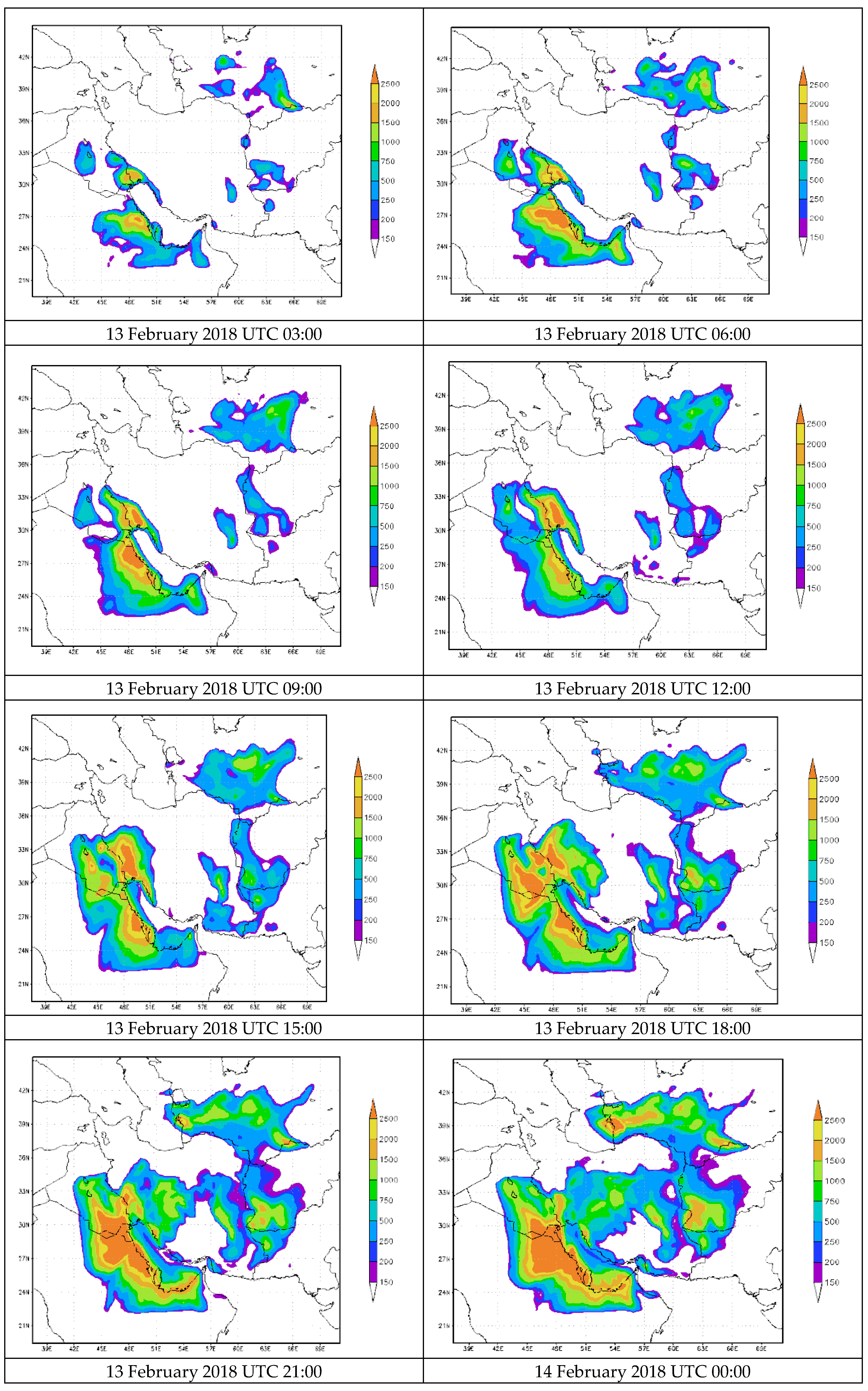
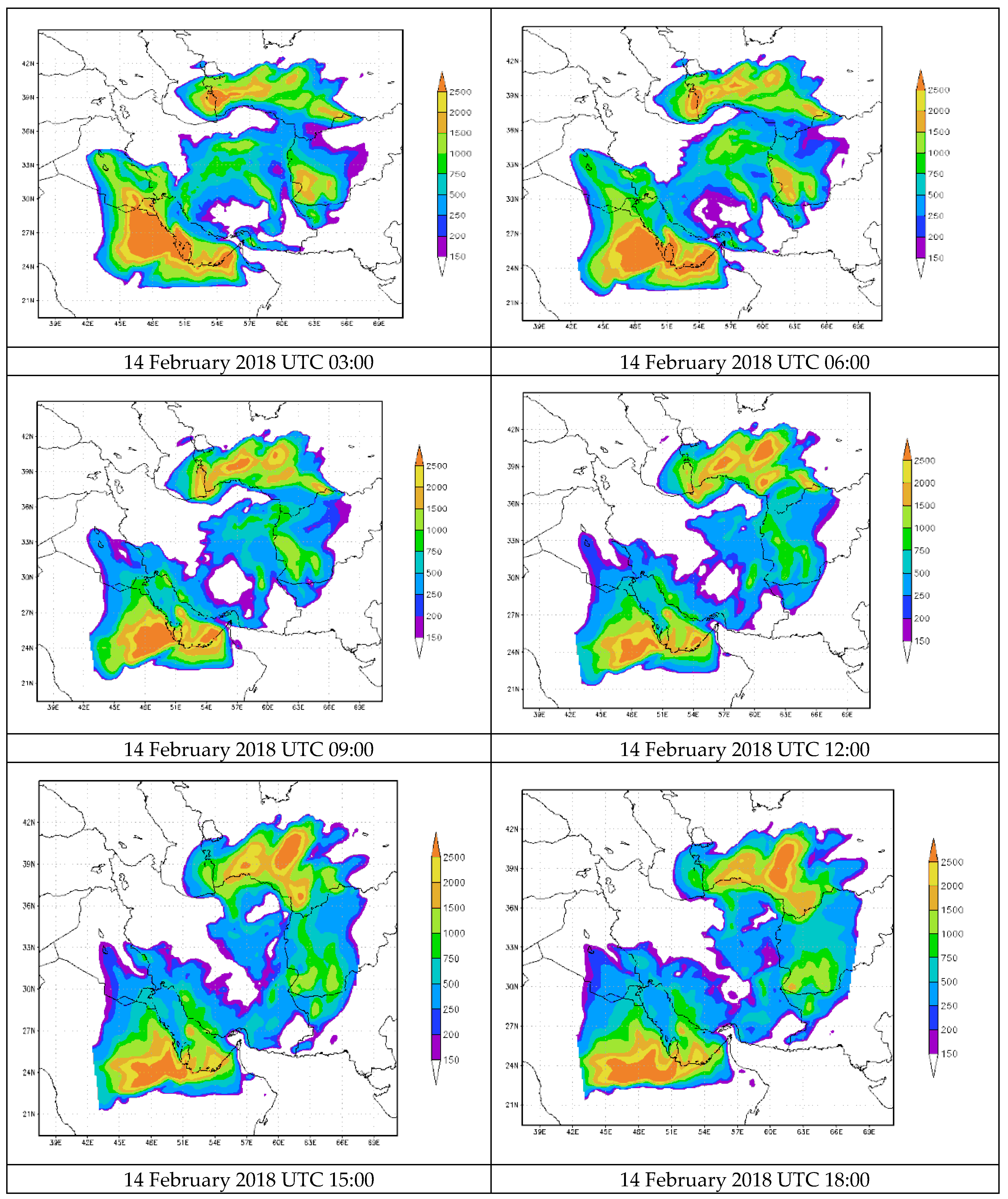
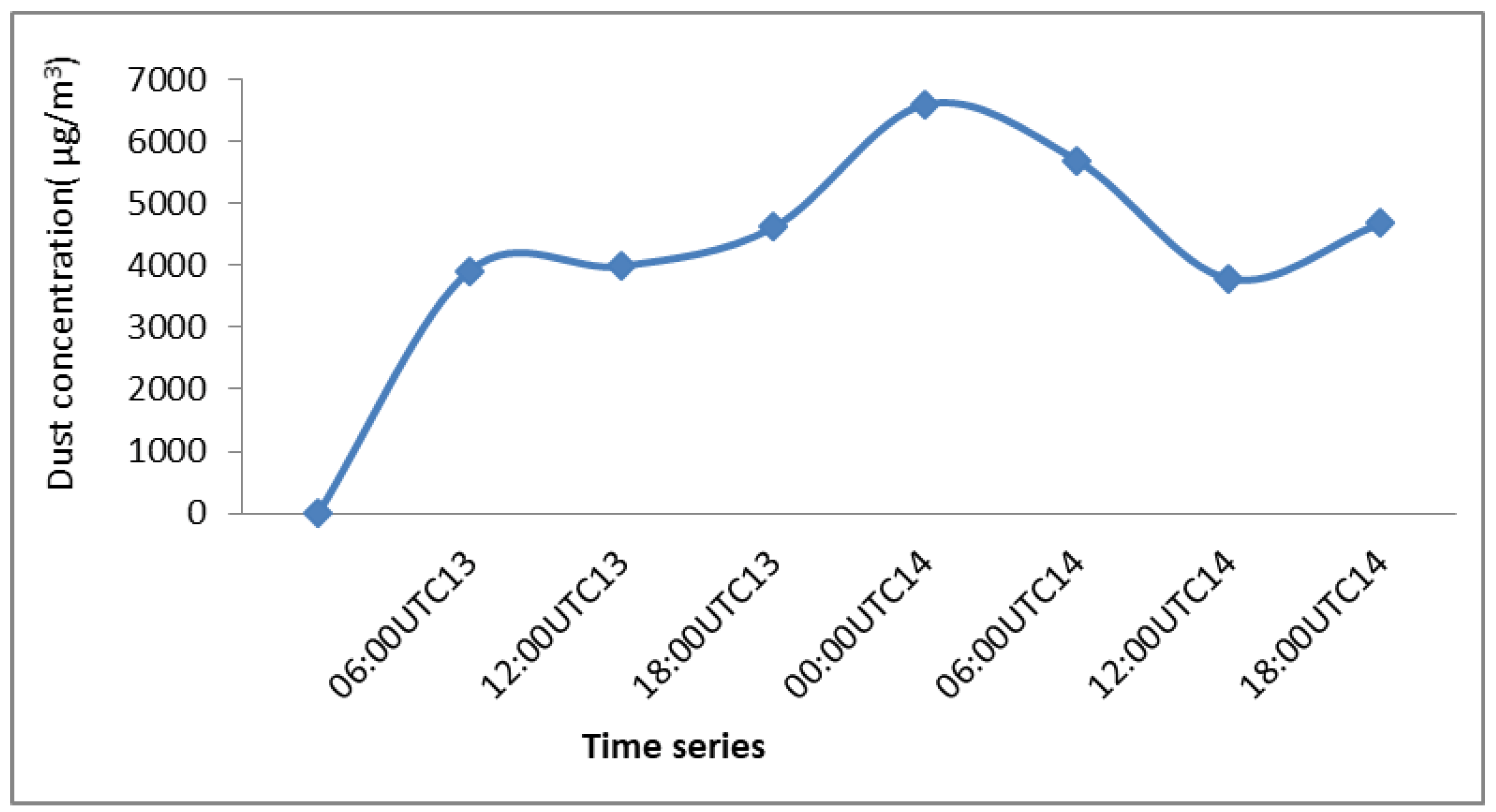
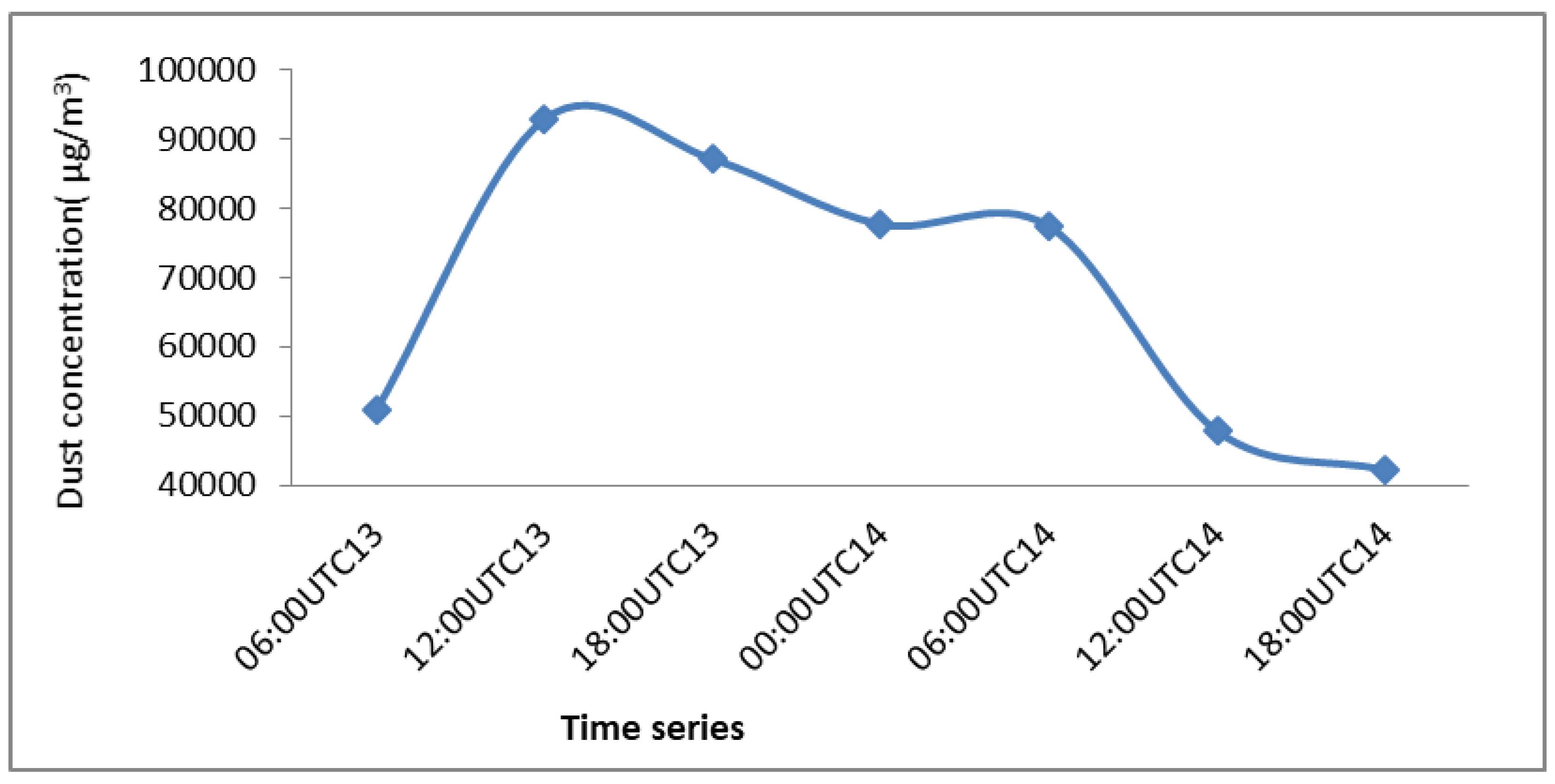
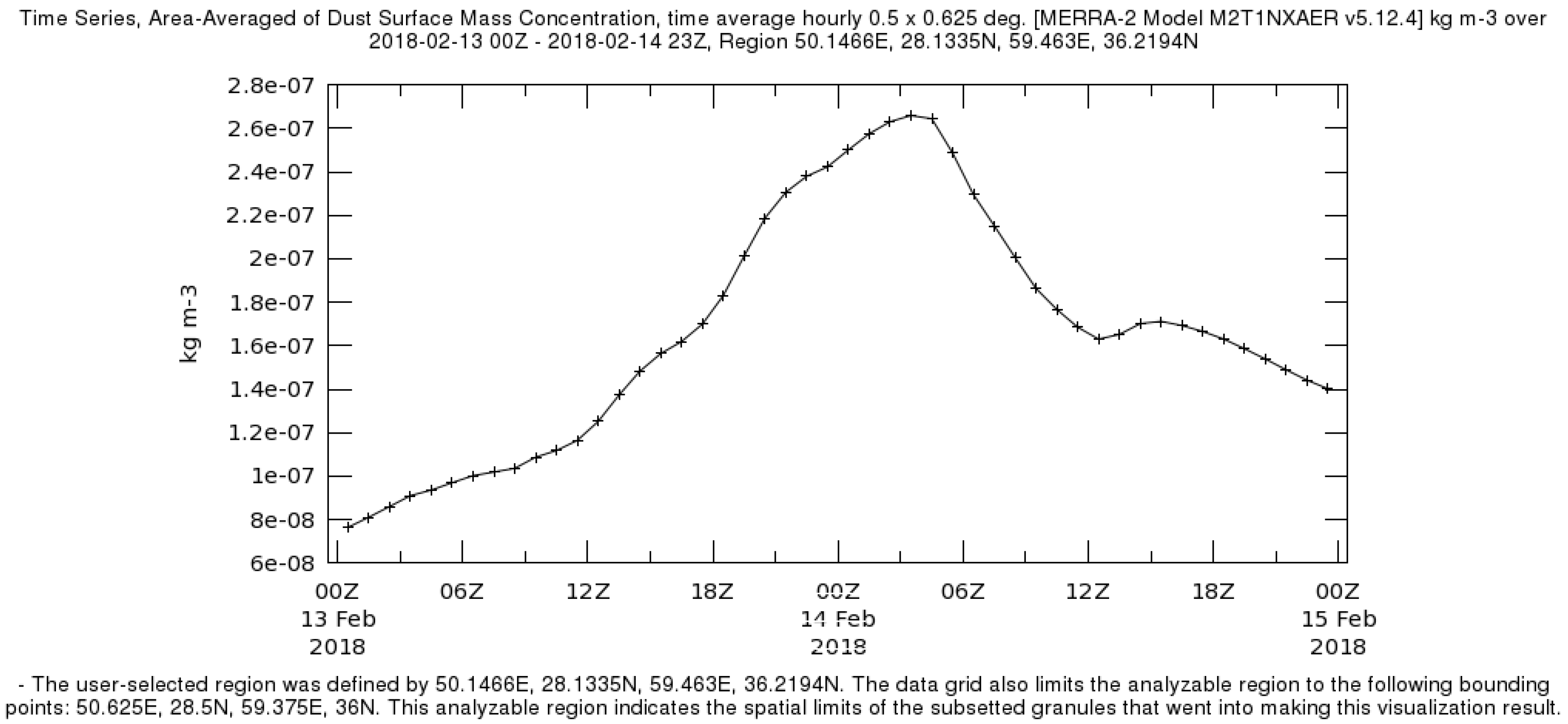
| Description | Name | Weather Codes |
|---|---|---|
| Suspended dust that has traveled long distances. | Suspended dust | 06 |
| Dust or sand rising from the station to the Atmosphere. | Dust | 07 |
| Evolving Whirlwind at or near the station. | Whirlwind | 08 |
| There is dust when observation in around of the station or already existed at the station. | Storm | 09 |
| The intensity of the storm has declined over the past hour. | Dust storm with mild sand | 30 |
| The intensity of the storm has not changed over the past hour. | Dust storm with mild sand | 31 |
| The intensity of the storm has increased over the past hour. | Dust storm with mild sand | 32 |
| The intensity of the storm has declined over the past hour. | Dust storm with severe sand | 33 |
| The intensity of the storm has not changed over the past hour. | Dust storm with severe sand | 34 |
| The intensity of the storm has increased over the past hour. | Dust storm with severe sand | 35 |
| Statistical Period | Longitude (Degree) | Latitude (Degree) | Station Name | Statistical Period | Longitude (Degree) | Latitude (Degree) | Station Name |
|---|---|---|---|---|---|---|---|
| 2006–2018 | 53.08 | 32.58 | Naein | 2006–2018 | 60.47 | 29.47 | Zahdan |
| 2006–2018 | 51.90 | 33.53 | Natanz | 2006–2018 | 54.28 | 31.90 | Yazd |
| 2006–2018 | 51.83 | 31.98 | Shahr Reza | 2006–2018 | 54.25 | 30.50 | Marvast |
| 2006–2018 | 55.25 | 30.88 | Anar | 2006–2018 | 53.62 | 32.43 | Aqda |
| 2006–2018 | 58.35 | 29.10 | Bam | 2006–2018 | 53.42 | 35.59 | Semnan |
| 2006–2018 | 57.67 | 28.73 | Jiroft | 2006–2018 | 52.28 | 32.89 | Birjand |
| 2006–2018 | 57.70 | 27.97 | Kahnooj | 2006–2018 | 56.90 | 33.67 | Tabas |
| 2006–2018 | 56.97 | 30.25 | Kerman | 2006–2018 | 58.18 | 34.03 | Ferdous |
| 2006–2018 | 57.70 | 30.42 | Shahdad | 2006–2018 | 50.85 | 34.70 | Qom |
| 2006–2018 | 55.13 | 30.10 | Shahr Babak | 2006–2018 | 51.18 | 34.78 | Salafchegan |
| 2006–2018 | 55.68 | 29.55 | Sirjan | 2006–2018 | 49.83 | 34.13 | Arak |
| 2006–2018 | 50.90 | 35.92 | Karaj | 2006–2018 | 50.48 | 33.88 | Mahalat |
| 2006–2018 | 50.75 | 36.00 | Hashtgerd | 2006–2018 | 50.33 | 35.05 | Saveh |
| 2006–2018 | 50.00 | 36.25 | Qazvin | 2006–2018 | 57.65 | 36.18 | Sabzevar |
| 2006–2018 | 49.70 | 36.05 | Takestan | 2006–2018 | 52.38 | 33.38 | Ardestan |
| 2006–2018 | 51.32 | 35.75 | Abali | 2006–2018 | 51.71 | 32.52 | Isfahan |
| 2006–2018 | 52.83 | 35.92 | Firozkoh | 2006–2018 | 51.85 | 32.52 | Kabootar-khan |
| 2006–2018 | 5132 | 35.68 | Mehrabad | 2006–2018 | 55.08 | 33.78 | Khoor va bibanak |
| WRF Single-Moment 5-class | Micro-scale physics |
| RRTM | Long wave radiation |
| Goddard shortwave | Shortwave radiation |
| Noah Land Surface Model | Surface Physics |
| YSU | Boundary layer |
| Grell 3D | Cumulus Convection |
| Particle Density (g/cm3) | Particle Diameter Range (μm) | Effective Particle Diameter (μm) | Type of Dust Particle (p) |
|---|---|---|---|
| 2500 | 0–1.0 | 0.73 | bin1 |
| 2650 | 1.0–1.8 | 1.4 | bin2 |
| 2650 | 1.8–3.0 | 2.4 | bin3 |
| 2650 | 3.0–6.0 | 4.5 | bin4 |
| 2650 | 6.0–10.0 | 8 | bin5 |
© 2020 by the authors. Licensee MDPI, Basel, Switzerland. This article is an open access article distributed under the terms and conditions of the Creative Commons Attribution (CC BY) license (http://creativecommons.org/licenses/by/4.0/).
Share and Cite
Mesbahzadeh, T.; Salajeghe, A.; Sardoo, F.S.; Zehtabian, G.; Ranjbar, A.; Marcello Miglietta, M.; Karami, S.; Krakauer, N.Y. Spatial-Temporal Variation Characteristics of Vertical Dust Flux Simulated by WRF-Chem Model with GOCART and AFWA Dust Emission Schemes (Case Study: Central Plateau of Iran). Appl. Sci. 2020, 10, 4536. https://doi.org/10.3390/app10134536
Mesbahzadeh T, Salajeghe A, Sardoo FS, Zehtabian G, Ranjbar A, Marcello Miglietta M, Karami S, Krakauer NY. Spatial-Temporal Variation Characteristics of Vertical Dust Flux Simulated by WRF-Chem Model with GOCART and AFWA Dust Emission Schemes (Case Study: Central Plateau of Iran). Applied Sciences. 2020; 10(13):4536. https://doi.org/10.3390/app10134536
Chicago/Turabian StyleMesbahzadeh, Tayyebeh, Ali Salajeghe, Farshad Soleimani Sardoo, Gholamreza Zehtabian, Abbas Ranjbar, Mario Marcello Miglietta, Sara Karami, and Nir Y. Krakauer. 2020. "Spatial-Temporal Variation Characteristics of Vertical Dust Flux Simulated by WRF-Chem Model with GOCART and AFWA Dust Emission Schemes (Case Study: Central Plateau of Iran)" Applied Sciences 10, no. 13: 4536. https://doi.org/10.3390/app10134536
APA StyleMesbahzadeh, T., Salajeghe, A., Sardoo, F. S., Zehtabian, G., Ranjbar, A., Marcello Miglietta, M., Karami, S., & Krakauer, N. Y. (2020). Spatial-Temporal Variation Characteristics of Vertical Dust Flux Simulated by WRF-Chem Model with GOCART and AFWA Dust Emission Schemes (Case Study: Central Plateau of Iran). Applied Sciences, 10(13), 4536. https://doi.org/10.3390/app10134536







